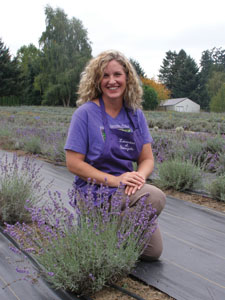2/15/2009
Love of Lavender
Barbara Mulhern

Lavender is her passion. Lavender spray, lavender body wraps, lavender filled sachets—but especially growing lavender plants.
“I spent all of my summers at the family farm in Oklahoma when I was a kid. Everyone on my mother’s side of the family is a farmer,” says Sarah Bader, owner of Lavender of Stonegate Farm in West Linn, Oregon. “I was an engineering recruiter before this but then I decided to go with my passion. If I wouldn’t have tried it, I wouldn’t have known that I could do it.”
Sarah bought her current property, a hazelnut orchard, in 2000. But the 350 hazelnut trees “caught blight and died,” she says. Sarah took a trip to Washington State, saw what some of the small growers there were doing with lavender and decided to give it a try.
When she started planting in 2003, however, she found that 75% of the starts she received from another grower had been mislabeled. “Then I did a bunch of research and realized that this problem is pretty pervasive with lavender,” she says. “Especially with the bigger companies, 70% to 80% of the lavender you see is brought in from Costa Rica and other countries. They fly in their starts, which end up at a couple of different other places before they get to the nurseries here. So mislabeling is common.”
Learning from others
Sarah began immersing herself in her research and learned that eight of the 10 lavender growers mentioned in a book she read were located in Oregon. So she befriended them, asked a lot of questions and then began bringing in new species. “I realized that there was a market for this when I decided to take my own cuttings and propagate them,” she says. “There are maybe four or five other people in Oregon and Washington who do what I do—take their own cuttings. I get a lot of calls from people who want to start a lavender farm.”
As Sarah gradually began growing her business, she at one point had a customer who wanted 9,000 lavender plants. “But by the time she got them about half of them were not true to species. I had to pull out 4,500 of her plants,” she says.
Today Sarah grows about 5,000 different plants including Lavandula angustifolia (such varieties as Purple Bouquet, Folgate, Buena Vista, Croxton’s Wild and Betty’s Blue), Lavandula x chaytorae and Lavandula x intermedia (such varieties as Edelweiss, True Grosso and Provence). All of the plants are propagated on her own farm through cuttings from her own stock. She has three greenhouses for finished plant growing space and has been in the process of adding a fourth. During propagation, Sarah has about six employees but has just a couple of employees the rest of the year.
Sarah sells both wholesale and retail, but she has been downsizing the retail part of her business. “Because we grow so much lavender we have a lot of end product, such as body wraps, which we sell. But probably 70% of our business is the plants. I’ve found that our niche seems to be working with the plants. So we’re focusing more on the plant end,” she says.
On the wholesale side, a lot of Sarah’s customers want lavender for a specific purpose. “For example, we have a lot of wine grape growers. Lavender is a great pollinator to keep the bees around. Lavender is also a good deer deterrent,” she says.
Her wholesale customers include persons “who really love gardening. We get quite the age range. Some say their grandmother loved lavender. Either people absolutely love it or they can take it or leave it.”
Tips for other growers
Sarah has learned a lot from her experiences with lavender over the past several years. She has these tips for other growers thinking about producing the plant:
• Decide what you’re going to do with the lavender before you plant it. “For example, if you want to sell a certain type at a farmer’s market, figure out which species will work. Some people want to use it for culinary purposes, some for sachets, some for oil. We do free consultations on this.”
• Know your costs. “It might cost you about $3,000 per acre to get started. You may have to amend the soil and possibly put in a drip system. And there will be additional upfront costs.”
• Know what other problems you might encounter. “Lavender is actually an easy plant to grow. It’s very hardy. There are certain varieties that grow well in Zone 5. Idaho got 147 inches of snow (during winter 2007-2008) but a customer told me all of the lavender plants survived.” Nonetheless, Sarah notes that most lavender grows in mild winters where temperatures don’t go below freezing. Also, you need to have good drainage, know how to trim the plants correctly and know how far apart to space them. “Lavender generally grows in well-drained, sandy soil with a pH level of around 7.0. It can be grown in clay soil as well but must have good drainage,” she stresses.
As for Sarah’s future, she anticipates adding yet more varieties. “We recently added Lavandula viridis. This is a yellow-blooming lavender that smells like lemon.” she says. She also plans to continue streamlining her business “so we can grow what sells the most.”
Barbara Mulhern is a freelance writer from Verona, Wisconsin.